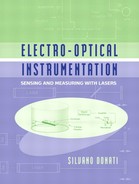Appendix A4
Optimum Filter for Timing
The optimum filter derived in this appendix is just an example of the time-domain optimization of signal processing, a well-developed method found useful in a number of measurement applications [1].
To derive the optimum impulse response, we will represent the statistical properties of the signal at the second order, using mean value S(t) and covariance K(t,t’) [1,2].
For a process dominated by shot-noise fluctuation, we may write the covariance as K(t,t’)= S(t) δ(t’-t), where δ is the Dirac-delta function.
When the signal is passed through a filter with impulse response h(t), the output mean and covariance are given by [2]:
(A4.1)
![]()
The time variance σ2t of a threshold crossing is accordingly, using a linear regression:
(A4.2)
![]()
To find the minimum of σ2t with respect to the function h(t), we use a method due to Hilbert [1,2]. We let h(t)=h0(t)+αη(t), where h0(t) is the desired optimum function to be found, α is a free numerical parameter, and η(t) is an arbitrary function. If h0(t) is the function that minimizes σ2t, then the second term in Eq.A4.2 will be a minimum for α=0, irrespective of the chosen η(t). Thus, we may substitute h(t)=h0(t)+αη(t) in Eq.A4.2 and look for the minimum with respect to α. In this way we obtain:
![]()
By developing the derivatives and equating to zero, we get:
![]()
Now, letting α=0 in the above expression, we obtain:
![]()
It can be verified that this condition is satisfied for any arbitrary function η(t) by taking:
(A4.3)
![]()
Thus, the optimum filter function is the time-reverse of the relative slope S’/S. The time t of reversal is not specified in the calculation, but to make sense, it should be larger than the time duration of the pulse S(t). Taking t=Tm according to this criterion, we have:
(A4.4)
![]()
or, the mean signal passes through zero at time Tm, i.e., we have to perform a zero-crossing measurement. The timing variance supplied by the optimum filter at t=Tm is:
(A4.5)
![]()
a value is obviously smaller than σ2t=1/[S’2(τ)/S(τ)], the value of a fixed threshold crossing.
As a final point, let us account for background and electronic circuit noise. We can summarize the signal-independent noise by adding a term ρ to the amplitude variance, where ρ can be written in terms of Pbg+Pph0 (see Sect.3.2.3). With such a position, it is easy to repeat the calculations leading to Eq.A4.3 and we find the optimum filter response to be:
(A4.4’)
![]()
Again, the output signal passes through zero at measurement time Tm, or Sout(Tm)=0, and the optimum time variance is:
(A4.5’)
![]()
By inserting a normalized waveform function in Eq.A4.5’ and after some algebraic manipulation, we can arrive at a time accuracy expression coincident to Eqs.3.16’ and 3.16’’ of this text. This result confirms the ![]() and 1/Nr dependence of accuracy from the received number of photons, for the shot noise and background or electronics noise respectively.
and 1/Nr dependence of accuracy from the received number of photons, for the shot noise and background or electronics noise respectively.
References
[1] S. Donati, E. Gatti, and V. Svelto, “Advances in Electronics and Electron Physics”, vol.26, edited by L. Marton, Academic Press: New York, 1969, pp.251-307.
[2] E. Gatti and S. Donati, “Optimum Signal Processing for Distance Measurements with Lasers”, Applies Optics, vol.10 (1971), pp.2446-2451.
